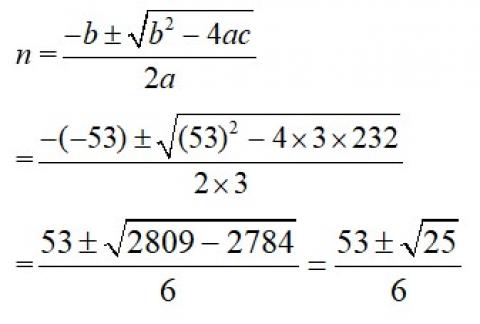Class 11th
Get insights from 8k questions on Class 11th, answered by students, alumni, and experts. You may also ask and answer any question you like about Class 11th
Follow Ask QuestionQuestions
Discussions
Active Users
Followers
New answer posted
6 months agoContributor-Level 10
21. Given, ak =5k+1
Putting k =1,
a1 =5 * 1+1=5+1=6.
an =5n+1=l
So, sum of unto n teams of the AP, Sn =
Sn =
= .
New answer posted
6 months agoContributor-Level 10
20. The given A.P. is 25,22,19, …
So, a=25
d=22 – 25= –3
Given that, sum of first n terms of the AP=116.

n [2 * 25+ (n – 1) (–3)]=116 * 2
n [50 – 3n+3]=232
n [53 – 3n]=232 .
53n – 3n2=232.
3n2 – 53n+232.
Using quadratic formula, a=3, b= –53, c=232.

n = or
= or
= or 8.
As n N, n=8.
? Last term=a+ (n – 1)d
=a+ (8 – 1)d
=25+7* (–3)
=25 – 21
=4.
New answer posted
6 months agoContributor-Level 10
19. Let a and d be the first term and the common difference of an A.P.
Then, given ap =
a+(p – 1)d = --------(1)
and aq =
a+(q – 1)d = ---------(2)
Subtracting eqn (2) from (1) we get,
a+(p – 1)d – [a+(q – 1)d]=
a+(p – 1)d– a–(q– 1)d=
[(p – 1)–(q – 1)]d=
[p – 1 – q+1]d=
[p – q]d= .
d= .
Putting d= in eqn (1) we get,
.
.
So, sum of first pq terms,
= .
=
New answer posted
6 months agoContributor-Level 10
18. Let the sum of n farms of the A.P –6, , –5, …. gives –25.
Then,

From the given A.P.
a= –6
d= –
So, –25=
–25 * 2=n
–50=n
–50=n
–50 * 2 =n[n – 25]=n2 – 25n
n2 – 25n+100=0.
n2 – 5n – 20n+100=0
n(n – 5) – 20(n – 5)=0
(n – 5)(n – 20)=0
So, n=5 and n=20.
When n=5
= –25.
When n=20
= = –120 + 19 * 5 = –120 + 95 = –25.
New answer posted
6 months agoContributor-Level 10
17. Given, a=2
Let A1, A2, A3, A4, A5, A6, A1, A6, A7, A10 be the first ten terms. So, A1=a.
Given A1+A2+A3+A4+A5= (A6+A1+A8+A1+A10)
a+ (a+d)+ (a+2d)+ (a+3d)+ (a+4d)
= [ (a+5d)+ (a+6d)+ (a+7d)+ (a+8d)+ (a+9d)]
5a+10d= [5a+35d].
4 [5a+10d]=9a+35d.
20a+40d=5a+35d.
40d – 35d=5a – 20a
5d= –15a
d= –3a
d= –3 * 2 [as a=2]
d= –6
So, A20=a+ (20 – 1)d
=2+19 * (–6)
=2 – 114
= –112.
New answer posted
6 months agoContributor-Level 10
16. Sum of all natural number between 100 and 1000 which are multiple of 5.
=105+110+115+ … +995.
So, a=105.
a=110 – 105=5.
As the last term is 995 which is the nthterm,
a+ (n – 1)d =995.
105+ (n – 1) * 5 =995.
(n – 1) * 5=995 – 105.
(n – 1)5 =890
n – 1 =
n =178+1
n =179
So, required sum Sn (a+l); l=last term.
= 179 * 550
=98450.
New answer posted
6 months agoContributor-Level 10
15. Sum of odd integers from 1 to 2001
=1+3+5+ … +2001
So, a=1
d=3 – 1=2
? For nth term,
an=a+ (n – 1)d.
? the last nth term is 2001,
2001 =1+ (n – 1)2.
(n – 1)2 =2001 – 1
n – 1=
n =1000+1
n =1001.
? Sum of n terms, Sn= (a + l); l = last term.
? Required sum = =1002001
New answer posted
6 months agoContributor-Level 10
14. Given, a1=1=a2.
an=an – 1+an – 2,n>2.
We need to find,
Putting n=3,4,5,6 in an=an – 1+an – 2 we have,
a3=a3 – 1+a3 – 2=a2+a1=1+1=2.
a4=a4 – 1+a4 – 2=a3+a2=2+1=3.
a5=a5 – 1+a5 – 2=a4+a3=3+2=5.
a6=a6 – 1+a6 – 2=a5+a4=5+3=8.
Now, to find ,
Substitute n=1,2,3,4,5.
.
New answer posted
6 months agoContributor-Level 10
13. Given,
a1=a2=2.
an=an – 1 – 1
Putting n=3,4,5.
a3=a3 – 1 – 1=a3 – 1 – 1=a2 – 1=2 – 1=1
a4=a4 – 1 – 1=a3 – 1=1 – 1=0
a5=a5 – 1 – 1=a4 – 1=0 – 1= –1 .
Hence the first five forms of the sequence are 2,2,1,0, –1.
And the series is 2+2+1+0+ (–1)+ ….
New answer posted
6 months agoContributor-Level 10
12. Given, a1= –1,
Putting n=2,3,4,5 we get,
.
So the first five terms of the sequence are –1, and .
And the series is .
Taking an Exam? Selecting a College?
Get authentic answers from experts, students and alumni that you won't find anywhere else
Sign Up on ShikshaOn Shiksha, get access to
- 65k Colleges
- 1.2k Exams
- 679k Reviews
- 1800k Answers
